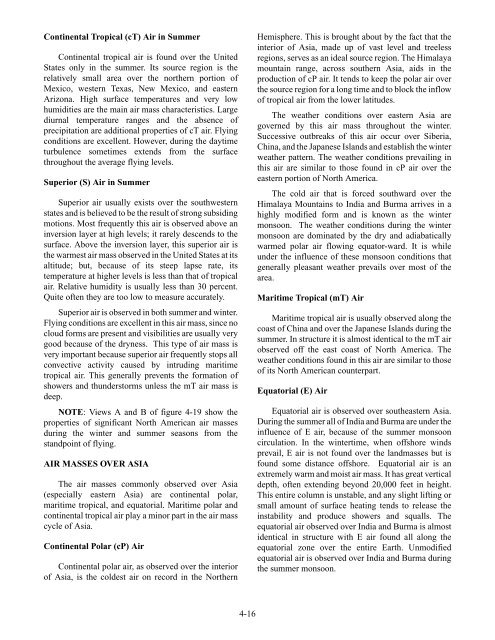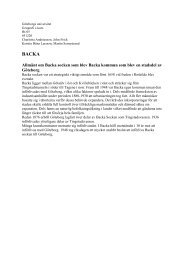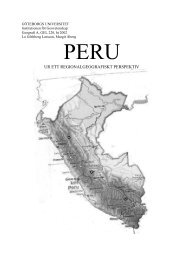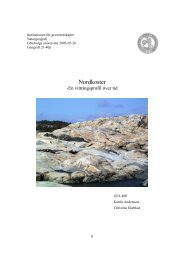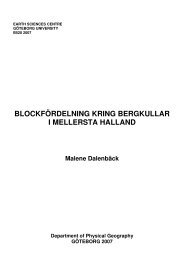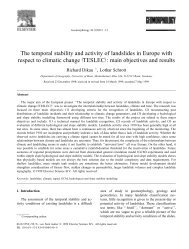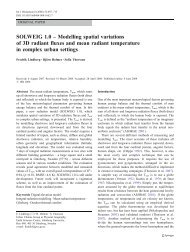AIR MASSES AND FRONTS
AIR MASSES AND FRONTS
AIR MASSES AND FRONTS
Create successful ePaper yourself
Turn your PDF publications into a flip-book with our unique Google optimized e-Paper software.
Continental Tropical (cT) Air in Summer<br />
Continental tropical air is found over the United<br />
States only in the summer. Its source region is the<br />
relatively small area over the northern portion of<br />
Mexico, western Texas, New Mexico, and eastern<br />
Arizona. High surface temperatures and very low<br />
humidities are the main air mass characteristics. Large<br />
diurnal temperature ranges and the absence of<br />
precipitation are additional properties of cT air. Flying<br />
conditions are excellent. However, during the daytime<br />
turbulence sometimes extends from the surface<br />
throughout the average flying levels.<br />
Superior (S) Air in Summer<br />
Superior air usually exists over the southwestern<br />
states and is believed to be the result of strong subsiding<br />
motions. Most frequently this air is observed above an<br />
inversion layer at high levels; it rarely descends to the<br />
surface. Above the inversion layer, this superior air is<br />
the warmest air mass observed in the United States at its<br />
altitude; but, because of its steep lapse rate, its<br />
temperature at higher levels is less than that of tropical<br />
air. Relative humidity is usually less than 30 percent.<br />
Quite often they are too low to measure accurately.<br />
Superior air is observed in both summer and winter.<br />
Flying conditions are excellent in this air mass, since no<br />
cloud forms are present and visibilities are usually very<br />
good because of the dryness. This type of air mass is<br />
very important because superior air frequently stops all<br />
convective activity caused by intruding maritime<br />
tropical air. This generally prevents the formation of<br />
showers and thunderstorms unless the mT air mass is<br />
deep.<br />
NOTE: Views A and B of figure 4-19 show the<br />
properties of significant North American air masses<br />
during the winter and summer seasons from the<br />
standpoint of flying.<br />
<strong>AIR</strong> <strong>MASSES</strong> OVER ASIA<br />
The air masses commonly observed over Asia<br />
(especially eastern Asia) are continental polar,<br />
maritime tropical, and equatorial. Maritime polar and<br />
continental tropical air play a minor part in the air mass<br />
cycle of Asia.<br />
Continental Polar (cP) Air<br />
Continental polar air, as observed over the interior<br />
of Asia, is the coldest air on record in the Northern<br />
4-16<br />
Hemisphere. This is brought about by the fact that the<br />
interior of Asia, made up of vast level and treeless<br />
regions, serves as an ideal source region. The Himalaya<br />
mountain range, across southern Asia, aids in the<br />
production of cP air. It tends to keep the polar air over<br />
the source region for a long time and to block the inflow<br />
of tropical air from the lower latitudes.<br />
The weather conditions over eastern Asia are<br />
governed by this air mass throughout the winter.<br />
Successive outbreaks of this air occur over Siberia,<br />
China, and the Japanese Islands and establish the winter<br />
weather pattern. The weather conditions prevailing in<br />
this air are similar to those found in cP air over the<br />
eastern portion of North America.<br />
The cold air that is forced southward over the<br />
Himalaya Mountains to India and Burma arrives in a<br />
highly modified form and is known as the winter<br />
monsoon. The weather conditions during the winter<br />
monsoon are dominated by the dry and adiabatically<br />
warmed polar air flowing equator-ward. It is while<br />
under the influence of these monsoon conditions that<br />
generally pleasant weather prevails over most of the<br />
area.<br />
Maritime Tropical (mT) Air<br />
Maritime tropical air is usually observed along the<br />
coast of China and over the Japanese Islands during the<br />
summer. In structure it is almost identical to the mT air<br />
observed off the east coast of North America. The<br />
weather conditions found in this air are similar to those<br />
of its North American counterpart.<br />
Equatorial (E) Air<br />
Equatorial air is observed over southeastern Asia.<br />
During the summer all of India and Burma are under the<br />
influence of E air, because of the summer monsoon<br />
circulation. In the wintertime, when offshore winds<br />
prevail, E air is not found over the landmasses but is<br />
found some distance offshore. Equatorial air is an<br />
extremely warm and moist air mass. It has great vertical<br />
depth, often extending beyond 20,000 feet in height.<br />
This entire column is unstable, and any slight lifting or<br />
small amount of surface heating tends to release the<br />
instability and produce showers and squalls. The<br />
equatorial air observed over India and Burma is almost<br />
identical in structure with E air found all along the<br />
equatorial zone over the entire Earth. Unmodified<br />
equatorial air is observed over India and Burma during<br />
the summer monsoon.


